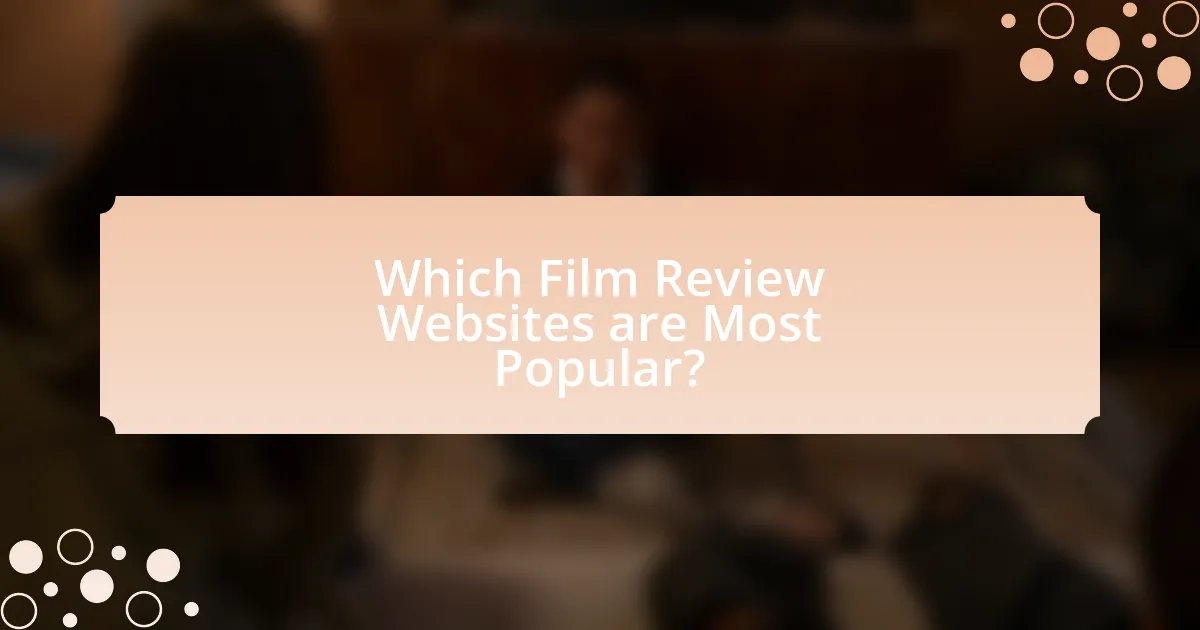The article provides a comparative analysis of the best film review websites, highlighting key platforms such as Rotten Tomatoes, Metacritic, IMDb, and Letterboxd. It examines how these websites influence audience perceptions and viewer choices through aggregated critic and user reviews. The article also discusses the importance of credibility in reviews, the role of user engagement, and the unique features of each platform. Additionally, it addresses how these websites cater to different audiences and the best practices for users to enhance their experience while navigating film reviews.

What are the Best Film Review Websites?
The best film review websites include Rotten Tomatoes, Metacritic, IMDb, and Letterboxd. Rotten Tomatoes aggregates reviews from critics and audiences, providing a percentage score that reflects overall reception. Metacritic offers a weighted average score based on critic reviews, allowing users to see a film’s critical consensus. IMDb is a comprehensive database that includes user-generated ratings and reviews, making it a popular choice for film enthusiasts. Letterboxd focuses on social interaction, allowing users to track films they’ve watched and share reviews with a community. These websites are widely recognized for their reliability and user engagement in the film industry.
How do film review websites influence audience perceptions?
Film review websites significantly influence audience perceptions by shaping expectations and guiding viewing choices. These platforms aggregate critiques from various sources, providing a consensus that can sway potential viewers. For instance, a study published in the Journal of Communication found that films with higher ratings on review aggregator sites like Rotten Tomatoes tend to attract larger audiences, demonstrating a direct correlation between online ratings and box office performance. Additionally, audience reviews and ratings on these websites can create a bandwagon effect, where individuals are more likely to watch films that are perceived as popular or critically acclaimed. This influence is further amplified by the accessibility of these reviews, as they are often the first point of reference for potential viewers seeking information about a film.
What role do critic reviews play in shaping viewer choices?
Critic reviews significantly influence viewer choices by providing expert assessments that help audiences evaluate films before watching. These reviews often highlight key elements such as storytelling, direction, and performances, which can sway potential viewers’ perceptions and decisions. For instance, a study published in the Journal of Marketing Research found that positive critic reviews can increase box office revenue by up to 20%, demonstrating their impact on consumer behavior. Additionally, platforms like Rotten Tomatoes aggregate critic scores, which serve as a quick reference for viewers, further solidifying the role of critic reviews in shaping viewing preferences.
How do user reviews complement professional critiques?
User reviews complement professional critiques by providing diverse perspectives and real-world experiences that enhance the understanding of a film. While professional critiques often focus on technical aspects such as cinematography, direction, and narrative structure, user reviews reflect personal enjoyment, emotional impact, and relatability, which can resonate with a broader audience. For instance, a professional critic may highlight a film’s artistic merits, while user reviews might emphasize how the film connects with everyday life or specific demographics. This combination allows potential viewers to gauge both the artistic value and the emotional appeal of a film, leading to a more comprehensive evaluation.
What criteria should be considered when evaluating film review websites?
When evaluating film review websites, key criteria include credibility, user engagement, and diversity of perspectives. Credibility can be assessed by examining the qualifications and expertise of the reviewers, as well as the website’s reputation within the film industry. User engagement is important, as websites that foster community interaction through comments and discussions often provide richer insights. Additionally, diversity of perspectives ensures a well-rounded view of films, as multiple opinions can highlight different aspects of a movie. These criteria are essential for determining the reliability and usefulness of film review websites.
How important is the credibility of the reviewers?
The credibility of reviewers is crucial in film reviews as it directly influences audience trust and decision-making. Credible reviewers are often recognized for their expertise, experience, and unbiased opinions, which enhances the reliability of their assessments. Research indicates that consumers are more likely to rely on reviews from established critics or platforms with a history of accurate evaluations, as seen in a study by the Pew Research Center, which found that 82% of people trust online reviews as much as personal recommendations. This trust is essential for film review websites to maintain their authority and attract a loyal audience.
What features enhance the user experience on these websites?
User experience on film review websites is enhanced by features such as intuitive navigation, responsive design, and personalized content recommendations. Intuitive navigation allows users to easily find reviews and information, which is crucial for retaining visitors. Responsive design ensures that the website functions well on various devices, improving accessibility and user satisfaction. Personalized content recommendations, often powered by algorithms, help users discover films that match their interests, increasing engagement. These features collectively contribute to a more enjoyable and efficient browsing experience, as evidenced by user feedback and engagement metrics that show higher retention rates on sites that implement them effectively.

Which Film Review Websites are Most Popular?
The most popular film review websites include Rotten Tomatoes, IMDb, Metacritic, and Letterboxd. Rotten Tomatoes is widely recognized for its aggregation of critic and audience scores, with over 300,000 reviews contributing to its ratings. IMDb, with its extensive database, features user-generated ratings and reviews, making it a go-to for film enthusiasts. Metacritic aggregates reviews from critics and assigns a weighted average score, providing a comprehensive overview of a film’s reception. Letterboxd offers a social platform for users to track films, write reviews, and engage with a community, enhancing its popularity among cinephiles. These websites are frequently cited in discussions about film quality and audience reception, solidifying their status in the film review landscape.
What are the top film review websites currently available?
The top film review websites currently available are Rotten Tomatoes, Metacritic, IMDb, and Letterboxd. Rotten Tomatoes aggregates reviews from critics and audiences, providing a percentage score that reflects the overall approval rating of films. Metacritic offers a weighted average score based on critic reviews, allowing users to see a film’s critical reception at a glance. IMDb is a comprehensive database that includes user ratings and reviews, along with detailed information about films and television shows. Letterboxd serves as a social platform for film lovers, enabling users to track, rate, and review films while engaging with a community of cinephiles. These websites are widely recognized for their influence in the film industry and their ability to guide audience choices.
What unique features do Rotten Tomatoes and Metacritic offer?
Rotten Tomatoes offers a unique “Tomatometer” score that aggregates critic reviews into a percentage indicating the overall approval rating of a film, while Metacritic provides a “Metascore” that combines reviews into a weighted average score, reflecting the consensus of critics. The Tomatometer is visually represented with a fresh or rotten tomato icon, making it easily recognizable, whereas Metacritic’s scoring system ranges from 0 to 100, allowing for more nuanced differentiation between films. Additionally, Rotten Tomatoes features audience scores based on user ratings, while Metacritic includes user reviews that contribute to its overall score, providing a broader perspective on public reception.
How does IMDb compare to other film review platforms?
IMDb is the largest and most widely recognized film review platform, boasting over 10 million registered users and a database of more than 6 million titles. In comparison to other platforms like Rotten Tomatoes and Metacritic, IMDb offers a more extensive range of user-generated content, including reviews, ratings, and trivia, which enhances its community engagement. While Rotten Tomatoes focuses on aggregated critic scores and Metacritic provides a weighted average of reviews, IMDb’s user rating system allows for a broader representation of audience opinions, making it a unique resource for film enthusiasts. Additionally, IMDb’s comprehensive database includes detailed information about cast, crew, and production, which is not as extensively covered by its competitors.
What are the strengths and weaknesses of each popular film review website?
Rotten Tomatoes has the strength of aggregating reviews from multiple critics, providing a consensus score that is easily understandable. However, its weakness lies in the potential for misleading scores, as a film can have a high percentage of positive reviews but still be poorly received by audiences. IMDb’s strength is its extensive database and user-generated reviews, allowing for a broad perspective on films. Its weakness is that user ratings can be skewed by fan bases, leading to inflated scores. Metacritic excels in offering a weighted average of critic reviews, which can provide a more nuanced view of a film’s reception. However, its weakness is that it may not capture the full range of audience opinions, as it primarily focuses on critic reviews. Letterboxd’s strength is its community-driven platform that encourages detailed user reviews and discussions, fostering a sense of engagement among film enthusiasts. Its weakness is that it may lack the authority of professional critics, which can lead to a less reliable consensus on film quality. Each of these websites has distinct strengths and weaknesses that cater to different audiences and preferences in film criticism.
What advantages does Letterboxd provide for film enthusiasts?
Letterboxd offers several advantages for film enthusiasts, including a user-friendly platform for tracking films, sharing reviews, and discovering new content. The platform allows users to create personalized film lists, log their viewing history, and rate films, which enhances their engagement with cinema. Additionally, Letterboxd fosters a community where users can follow friends and other film lovers, facilitating discussions and recommendations. The platform’s extensive database includes user-generated content, which provides diverse perspectives on films, enriching the viewing experience. Furthermore, Letterboxd’s social features, such as commenting and sharing, encourage interaction and connection among film enthusiasts, making it a valuable resource for anyone passionate about movies.
How does The Guardian’s film section stand out from others?
The Guardian’s film section stands out due to its unique blend of critical analysis, diverse perspectives, and a strong emphasis on social issues within cinema. This section features in-depth reviews that not only evaluate films artistically but also contextualize them within broader cultural and political discussions, which is less common in other film sections. For instance, The Guardian often highlights independent and international films, providing coverage that reflects a commitment to inclusivity and representation, setting it apart from mainstream outlets that may prioritize blockbuster releases.

How do Film Review Websites Cater to Different Audiences?
Film review websites cater to different audiences by tailoring their content, tone, and features to meet the preferences and needs of various demographic groups. For instance, some websites focus on in-depth analysis and critical reviews, appealing to cinephiles and film students, while others prioritize user-generated content and ratings, attracting casual moviegoers. Additionally, websites may segment their audience by genre, offering specialized reviews for horror, romance, or independent films, thus enhancing relevance for specific viewer interests. Data from a 2022 survey indicated that 65% of users prefer sites that align with their viewing habits, demonstrating the effectiveness of targeted content strategies in engaging diverse audiences.
What types of audiences do these websites target?
These websites target diverse audiences, including film enthusiasts, casual viewers, industry professionals, and academic researchers. Film enthusiasts seek in-depth analysis and critiques, while casual viewers look for accessible reviews and recommendations. Industry professionals, such as filmmakers and critics, require detailed insights and trends, and academic researchers often seek scholarly articles and data on film theory and criticism. This segmentation is supported by the varying content styles and formats these websites employ, catering to the specific needs and preferences of each audience group.
How do niche film review sites serve specific genres or communities?
Niche film review sites serve specific genres or communities by providing tailored content that resonates with the interests and preferences of their target audience. These platforms often focus on particular genres, such as horror, indie, or foreign films, allowing them to curate reviews, articles, and discussions that reflect the unique characteristics and themes of those genres. For example, sites like Bloody Disgusting cater specifically to horror enthusiasts, offering in-depth analyses, news, and community engagement that mainstream sites may overlook. This specialization fosters a sense of belonging among users, as they can connect with like-minded individuals and access content that speaks directly to their tastes. Additionally, niche sites often feature contributions from genre experts or passionate fans, enhancing the credibility and relevance of the reviews.
What demographic trends are evident in the user bases of these sites?
Demographic trends in the user bases of film review websites indicate a predominance of younger audiences, particularly those aged 18 to 34. This age group represents a significant portion of users on platforms like Rotten Tomatoes and IMDb, where engagement is driven by social media influence and digital accessibility. Additionally, research shows that these sites attract a diverse demographic, with a notable representation of both genders, although some platforms may skew slightly towards male users. For instance, a 2022 survey by Statista revealed that 60% of IMDb users are male, while Rotten Tomatoes has a more balanced gender distribution. Furthermore, geographic data suggests that urban users are more likely to engage with these sites, reflecting trends in internet usage and film consumption in metropolitan areas.
How can users effectively utilize film review websites?
Users can effectively utilize film review websites by comparing multiple reviews to gain a comprehensive understanding of a film’s quality and themes. By reading diverse opinions from critics and audiences, users can identify common praises or criticisms, which helps in making informed viewing decisions. Research indicates that aggregating reviews from various sources, such as Rotten Tomatoes and Metacritic, can provide a more balanced perspective, as these platforms compile scores from numerous critics and user ratings, reflecting a broader consensus on a film’s merit.
What strategies can enhance the film selection process using reviews?
Utilizing aggregated ratings and sentiment analysis can significantly enhance the film selection process using reviews. Aggregated ratings provide a comprehensive overview of audience and critic opinions, allowing users to quickly assess a film’s overall reception. For instance, platforms like Rotten Tomatoes and Metacritic compile scores from various sources, offering a reliable metric for quality. Additionally, sentiment analysis tools can analyze the language used in reviews to gauge emotional responses, helping potential viewers understand the nuances of a film’s reception. Research indicates that films with higher aggregated scores tend to perform better at the box office, demonstrating the effectiveness of these strategies in guiding selection.
How can users discern reliable reviews from biased opinions?
Users can discern reliable reviews from biased opinions by evaluating the reviewer’s credibility, analyzing the review’s content for specific details, and checking for patterns in multiple reviews. Credible reviewers often have a history of providing balanced assessments and may disclose potential conflicts of interest. Detailed reviews that discuss specific aspects of a film, such as direction, acting, and cinematography, are generally more trustworthy than vague or overly emotional responses. Additionally, cross-referencing reviews from multiple sources can reveal inconsistencies or biases, helping users to form a more objective view.
What are the best practices for engaging with film review websites?
The best practices for engaging with film review websites include actively participating in discussions, providing constructive feedback, and sharing content on social media platforms. Engaging in discussions allows users to express their opinions and connect with other film enthusiasts, fostering a community atmosphere. Providing constructive feedback helps reviewers improve their content and encourages a dialogue that can enhance the overall quality of reviews. Sharing content on social media increases visibility for both the reviews and the website, driving traffic and engagement. These practices are supported by the fact that user interaction significantly boosts website traffic and community engagement, as evidenced by studies showing that websites with active user participation see higher retention rates and user satisfaction.
How can users contribute to the community on these platforms?
Users can contribute to the community on film review platforms by submitting their own reviews and ratings of films. This active participation helps to create a diverse range of opinions and insights, enriching the overall content available on the site. Additionally, users can engage in discussions by commenting on existing reviews, which fosters a sense of community and allows for the exchange of ideas. Many platforms also offer features for users to create lists or recommendations, further enhancing their involvement. This collaborative effort not only benefits individual users by allowing them to share their perspectives but also aids others in making informed viewing choices.
What tips can improve the overall experience of using film review websites?
To improve the overall experience of using film review websites, users should prioritize websites that offer comprehensive filtering options, allowing them to sort reviews by criteria such as genre, rating, and release date. This feature enhances user navigation and helps individuals find relevant content quickly. Additionally, websites that provide user-generated reviews alongside professional critiques foster a diverse range of opinions, enriching the decision-making process for viewers. Research indicates that platforms with interactive features, such as comment sections and rating systems, increase user engagement and satisfaction, as they allow for community interaction and feedback. Furthermore, ensuring that the website is mobile-friendly enhances accessibility, catering to users who prefer browsing on smartphones or tablets.